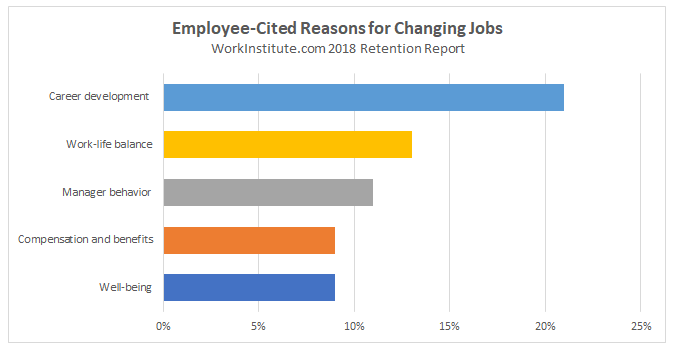With more job openings than unemployed workers to fill them, many people might find themselves wondering whether the grass is greener – or the money is better – on the other side of the fence. Here are six ways to combat high employee turnover before it becomes a talent drain.
WorkInstitute.com’s 2018 Retention Report offers valuable insights for businesses combating high employee turnover. In 2018, they estimated 42M workers changed jobs (or one of every four U.S. workers). With nearly full employment and a growing economy, employers competing to attract and retain talented workers would be wise to find ways to reduce voluntary turnover and discover whether top talent might be about to make a move.
To Leave or Not To Leave – Common Causes of High Employee Turnover
Of the 42 million workers who changed employers last year, the study estimates that 77 percent of the turnover could have been avoided.

When it came to employee-initiated separations, the top causes cited fell into five main categories:
- 21% – wanted a better opportunity or opportunities for advancement
- 13% – wanted to improve their work-life balance
- 11% – were unhappy with their manager
- 9% – left for well-being (personal or family health issues)
- 9% – left for a job with better pay and benefits
High employee turnover is an expensive problem. In addition to the money and time that goes into advertising and recruiting activities, organizations with high turnover also need to be aware of how time and resources needed for on-boarding, human resources tasks, training add to the cost of high employee turnover. The study estimated that turnover cost employers $600B in 2018 and will cost employers $680B in 2020.
If direct costs were not enough, high turnover usually results in decreased productivity and can negatively impact the customer experience and employee morale. And yet, fewer than one in three study respondents said they either have a proactive recruiting strategy in place or were in the process of defining a more strategic approach to the problem of employee turnover.
When you consider how many organizational resources are being spent filling open positions where employees left voluntarily, it stands to reason that even small reductions in employee turnover could have big benefits on an organization’s bottom line, including increasing profits, reducing expenses, and improving employee morale and the customer experience.
6 Ways to Slow Down High Employee Turnover
1. Make sure you find out why employees are really leaving.
When an employee is leaving voluntarily, and especially when it is a top performer, an employee in a hard-to-fill position or its a surprising (and unwanted) departure, make sure you know why they are really leaving. There are many reasons why an employee might not tell you the real reason they became dissatisfied or what benefits they perceived would be theirs if they left for opportunity. If you feel that you might not have the whole story, you can also see whether their co-workers or manager can shed additional light on the subject, or evaluate the opportunity they left your organization for to see whether you can identify advantages they might have found there.
2. Look for patterns.
Departments with higher turnover or positions that are hard to keep filled may be indicative of a variety of factors that can result in higher turnover. From a bad fit on the team, to a bad manager or a need to redefine a position’s responsibilities, organizational areas where you find higher than expected turnover should always get a closer look.
You might also like: So You Made a Bad Hire – Now What?
3. Do a competitive evaluation.
Do you know what direct and indirect competitors are offering employees in the way of salaries, benefits, bonuses and employee perks? Your competitive evaluation shouldn’t end with the reasons that customers shop elsewhere. Make sure that you know the most talented and skilled workers – the workers that could make your business more profitable – might choose a competitor’s employee culture over yours as well.
4. Benchmark vital statistics.
Just like a nurse might come in and take a patient’s vital statistics at a regular frequency, you should be ‘taking the pulse’ of your employee culture. Use surveys, polls and suggestion systems to gauge employee satisfaction and identify areas where the employee culture, compensation, or working conditions can be improved.
5. Get employees involved in shaping the organizational culture.
Nothing impacts buy-in so much as giving people a voice in the process and its outcomes. Whether you form committees to help improve different aspects of the employee experience or use surveys and polls to influence decision-making, make sure employees know how they can get involved in shaping employee culture and – in doing so – positively impact the organization as a whole.
6. Eliminate dead ends.
One of the main reasons employees leave voluntarily is for a better opportunity or one where they will have opportunities to advance. No employee in your organization should be in a dead end job! Whether the road to advancement is for them to get more training and skills or for the organization itself to grow, make sure that everyone knows that there is a ‘next level’ and has clear direction on how to get there.

